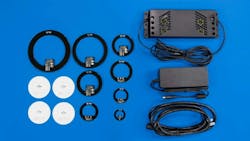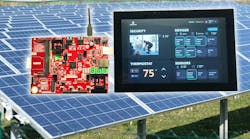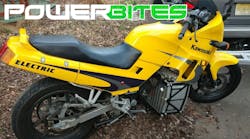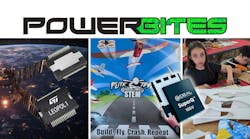Wireless Magnetic-Resonance Charging Dev Kit Delivers Up to 100 W
Powercast Corp. partnered with Etherdyne Technologies (ETI) to offer a wireless charging solution that can power multiple devices with up to 100 W of total power in a 3D magnetic energy field. It covers spaces as large as a common desktop (4 × 2 feet).
The solution provides an economical way to power higher-wattage charging for home, office, and industrial applications where multiple devices need power at the same time.
Based on Powercast's magnetic-resonance technology, and powered by ETI, the system uses a transmitter with a flexible wire loop that’s embedded into a surface. It creates a Wire-Free Power Zone that enables devices embedded with power receivers to convert the magnetic energy into electricity to power themselves or charge their batteries.
Example applications include a Wire-Free Desk that charges desktop components (i.e., a computer monitor, laptop charging stand, mouse, keyboard, a desk lamp, and Qi-compatible phone charger). The same technology can be used to create a Wire-Free Wall or Workbench, where power tools can be hung or placed to recharge.
An evaluation kit designed for R&D teams to explore magnetic-resonance Wire-Free Power is also available.
Next in This Edition of PowerBites
More PowerBites
About the Author
Lee Goldberg
Contributing Editor
Lee Goldberg is a self-identified “Recovering Engineer,” Maker/Hacker, Green-Tech Maven, Aviator, Gadfly, and Geek Dad. He spent the first 18 years of his career helping design microprocessors, embedded systems, renewable energy applications, and the occasional interplanetary spacecraft. After trading his ‘scope and soldering iron for a keyboard and a second career as a tech journalist, he’s spent the next two decades at several print and online engineering publications.
Lee’s current focus is power electronics, especially the technologies involved with energy efficiency, energy management, and renewable energy. This dovetails with his coverage of sustainable technologies and various environmental and social issues within the engineering community that he began in 1996. Lee also covers 3D printers, open-source hardware, and other Maker/Hacker technologies.
Lee holds a BSEE in Electrical Engineering from Thomas Edison College, and participated in a colloquium on technology, society, and the environment at Goddard College’s Institute for Social Ecology. His book, “Green Electronics/Green Bottom Line - A Commonsense Guide To Environmentally Responsible Engineering and Management,” was published by Newnes Press.
Lee, his wife Catherine, and his daughter Anwyn currently reside in the outskirts of Princeton N.J., where they masquerade as a typical suburban family.
Lee also writes the regular PowerBites series.





